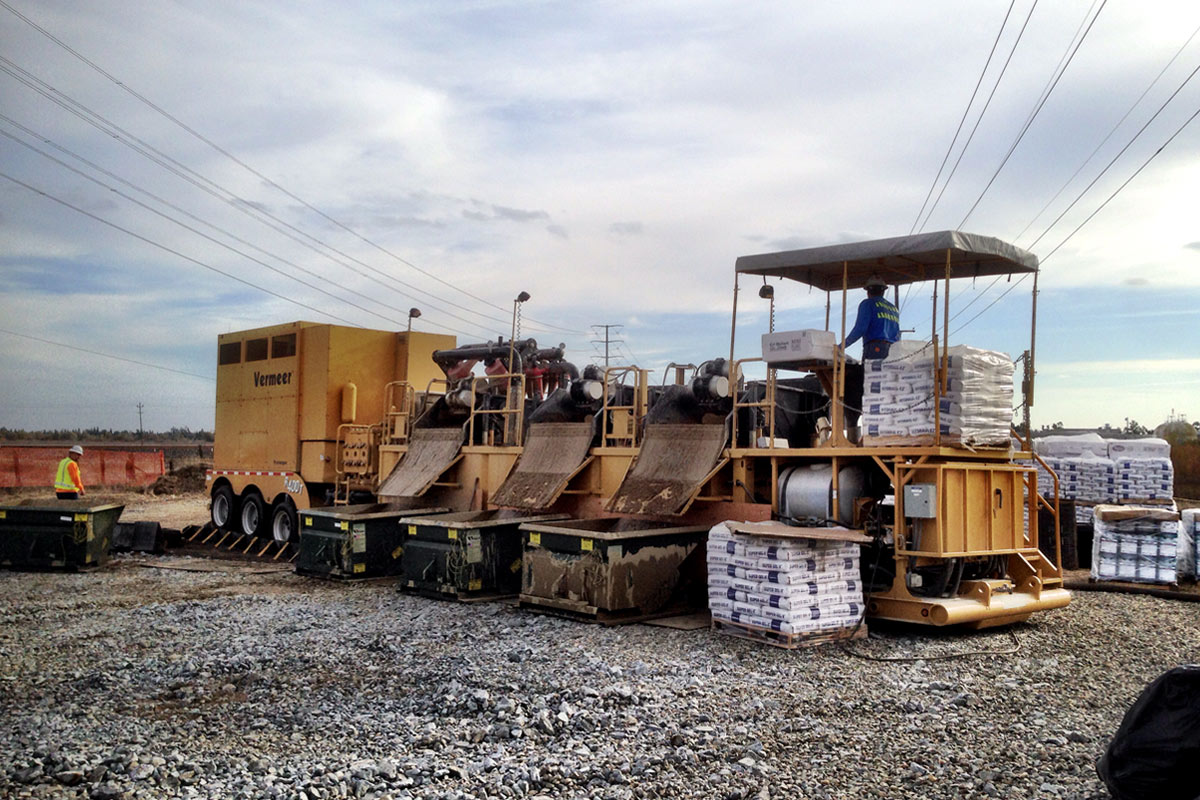Drilling into the Albermarle Sound

he concentrate water (or reject water) from the reverse osmosis process is brackish and must be discharged into a receiving water of similar quality. Currituck County was forced to discharge the concentrate water at the mouth of the North River and Albemarle Sound, 21 miles away from the plant site and approximately 1,800 ft off shore where flow was high enough to result in complete mixing.
The plan was to install the 16-in. HDPE pipe using HDD from a bore pit on shore about 400 ft from the waterline, 2,200 ft total. The project was awarded to RJS Utility, located in Kitty Hawk, N.C. Due to a riparian easement, a significant bend of approximately 18 degrees was required in order to remain within the easement boundaries. Had the pipe been drilled in a straight line from the staging area, the pipe would have crossed the easements of several adjacent riparian owners and the county would have had to obtain approval from multiple owners.
To tackle this tough bore, Spoloric purchased a Universal UNI-160×240 directional drill from Universal HDD, located in Lake Zurich, Ill.
“In my opinion, the Universal UNI-160×240 offers the most power and performance per dollar than any other manufacturer in the business” said RJS Utility owner Joe Spoloric. “With a 325-hp, John Deere engine, 260-gpm Kerr pump and 24,000 ft-lbs of rotation torque from the Hagglunds radial piston motor, this machine will get the job done.”
The pilot bore was planned to be approximately 34 ft deep, including the water depth. A standard carbide steering bit 8 in. wide was utilized to make the pilot bore. As the tide subsided, it was possible to begin locating the head using the walkover method using a DCI Digitrak Eclipse locator with an EXL transmitter with a lithium battery.
After 13 hours of drilling spread over two days, the pilot hole was completed. “The machine drilled out very fast,” said Spoloric, who operated the drill. “It is amazing how quickly the drill stem is ready to thread onto once my carriage is back and we punched out on the bottom of the Albemarle Sound just feet away from an anchored crane barge.”
Dean Bryant and Andrew Copeland, owners of MAD DAWG Inc., based in Station, N.C., were the prime contractor for this project and coordinated the crane barge, pipe fusion and diving operations. “Once we have all the pipe completely fused, we will float it about 15 miles from the State Park Facility located on the Atlantic side through the Pamlico Sound using a tow boat and a trail boat to keep the pipe from straying,” said Bryant.
“After a few hours, the towboat was visible coming around the point and we were very close to hooking up the pipe and start the back reaming process,” Bryant said.
“You can’t pre-ream this ground,” said Spoloric. “The plan was to use the UNI-Ring-Cutter hole opener, connected directly to the trailing UNI Maxi-Packer and pull the pipe in direct.”
As divers submerged into the Albemarle Sound to connect the crane to the drill head and pull the drill string to the surface, Copeland’s team prepared the tooling to connect to the drill string once the head was removed. Finally, after the seven-hour trip from the Atlantic side, the pipe was brought to the crane barge and Copeland’s team used a set of hydraulic tongues to remove the drill head and connect the swivel and hole opener tooling in preparation to begin pulling back. After four hours from drilling out on the bottom of the Albemarle Sound, the pipe and tooling were rigged and ready to go.
Utilizing MI-Swaco’s Max Bore HDD product supplied by Universal HDD, RJS Utility used a reclaiming system to keep up with the mud demand. “It was very important to get the viscosity correct and to keep back flow going,” Spoloric said.

As the first tool emerged from the ground into the entrance pit and mud was flowing strong, the packer became visible. A lot of quality planning and the proper equipment make difficult projects like this one possible. Now it was time for MAD DAWG Inc. to connect the final phase to the outfall pipe.
At the end of the outfall pipe, a diffuser header was installed and anchored to the sound bottom with timber piles and stainless steel u-bolts. The header was designed to convey the build out concentrate flow of 1.67 mgd. It consists of a 14-in. diameter, 52-ft long HDPE pipe with twelve 2-in. diffuser ports. Each port was equipped with a 2-in. duckbill style check valve that is designed to achieve a velocity of 9 ft/sec at the build out flow. Only four of the 12 ports, were required to maintain the desired discharge velocity at the current WTP capacity. The remaining eight ports were reserved for future phases and are currently blind flanged.
Mike Fry is sales manager with Universal HDD, based in Lake Zurich, Ill.




